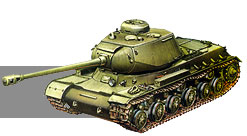


Translation
- serg@barakudaee
- 1 member
- 19 guests
- 6 robots
Visitors
| Today: | 57 |
| Yesterday: | 2524 |
| This Week: | 2581 |
| Last Week: | 16704 |
| This Month: | 49592 |
| Last Month: | 63448 |
| Total: | 134898 |
Last Heavy Tanks of the USSR |
 |
 |
Created Tuesday, 20 September 2005 18:06
|
|
Last Updated on Thursday, 04 February 2010 21:27
|
|
|
JS-4JS-4 Heavy TankIn 1944, the development of the JS-4 heavy tank (factory designation: JS-4-701) began. It was an attempt to develop a heavy tank for the last period of World War The production version of the tank was preceded by several prototypes: «Object 701-2», «Object 701-5», and «Object 701-6». These tanks were distinguished by their armament (type and caliber) as well as their armor protection. «Object 701-6» was the most successful, and in One of the main features of the new tank was the layout of the ammunition: This ammunition was placed in special steel cartridges to protect them from accidental detonation and fire. Today it is widely believed that - The weight of the tank exceeded the carrying capacity of most bridges and transport vehicles; JS-5JS-5 Heavy TankThis project began in JS-6JS-6 Heavy TankIn 1954, a new project was developed in Chelyabinsk, called «Object 253». It later received the «JS-6» designation. The main feature of the new tank was an electro-mechanical transmission. The chassis of the new tank was similar to the JS-2. There was also a tank developed and produced with a mechanical transmission such as on the JS-3. This tank received the «Object 252» designation. The chassis of «Object 252» consisted of big road wheels only (without support wheels). Later, Soviet designers chose the electro-mechanical transmission. The maximum speed of the 51.5-ton tank was The firepower of the JS-6 was equal to the JS-2, JS-3 or JS-4. Protection was better than the JS-2 or JS-3, but inferior to the JS-4. Use of the electro-mechanical transmission was expected to increase the maneuverability of the tank. Unfortunately, it did not due to the tank's heavy weight. The transmission was also of questionable reliability. The JS-6 with the purely mechanical transmission was even less reliable. JS-7JS-7 Heavy TankIn 1945, Soviet designers started a new project: «Object 260» (JS-7). This tank was distinguished from the tanks of World War Two by many features. The hull of «Object 260» was made of sloped armor plates with rakish angles. Only a wooden mockup (1:1) In 1946, another variant was built. This variant had the same designation («Object 260»). The first prototype was finished on September 8, 1946, and passed running trials successfully. A second prototype was completed by December One of the main features of both prototypes were An Izhorsky Factory manufactured two armored hulls and two turrets for the JS-7. They were tested at the Kubinka proving ground by gunfire from various guns of During 1947, Soviet designers worked on a project which was an improved variant of the JS-7. Both hull and turret were redesigned and their armor protection was increased. The tank was rearmed with the newest In the summer of 1948, the Kirovskiy factory produced four JS-7 tanks. After they passed the factory trials, they were sent for Government trials. The armor protection of the JS-7 was almost invulnerable: the tank successfully withstood German The JS-7 can be considered a masterpiece of Soviet tank development. It was far superior to all other tanks of the time. Having the weight of the «King Tiger» the JS-7 was far superior in protection and armament. The last surviving JS-7 is now displayed at Kubinka. JS-8, JS-9 (T-10)JS-8 and JS-9 (T-10) Heavy TanksAt the end of 1948, the GBTU (General Tank Directorate) issued an order to develop and produce a new heavy tank weighing no more than A wooden mockup (1:1) was built and construction of the first prototype of the JS-8 began. After trials, the factory produced a small lot of The modifications were so numerous and significant that the project changed course many times. The tank was even renamed to the «JS-9», and then to the «JS-10». In March 1953, Stalin died and the abbreviation «JS» was obsolete. So the tank was renamed again, and it received the new «T-10» designation. The T-10 was armed with a In 1957, another modification, the T-10B («Object 730B») was accepted into service. This tank was equipped with a 2-plane gun stabilizer, the PUOT-2 «Grom» and a Soon, a new In Object 277«Object 277»In 1957, «Object 277» was developed by The «Object 277» was equipped with an Object 279«Object 279»In 1957, a group of engineers, headed by The thickness of the glacis plate was Another unusual feature of the tank was the chassis. It consisted of four tracks combined in pairs. Such construction increased the tank's height, but guaranteed that the tank would rarely get bogged down. The tank also had great tractability on snowy and swampy terrain. At the end of 1957, a single tank had been built, but after that the project was abandoned. The «Object 279» is now displayed at Kubinka. Object 770«Object 770»Unlike «Object 277», this tank was based on several unique ideas. The tank was equipped with a nuclear defence system, automatic fire-extinguisher system, night vision equipment, and semi-gyrocompass. The thickness of the glacis plate was Having very good maneuverability, this tank was very easy to control. In a Soviet tank expert's opinion, «Object 770» was one of the most exemplary vehicles of the time. Today «Object 770» is displayed at Kubinka.
|
You need to login or register to post comments.
Add your comment. (total 0 comments)
© THE RUSSIAN BATTLEFIELD, 1998-2009






















